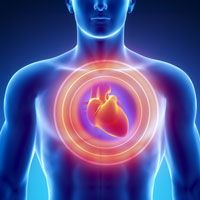Article
Gout Associated with Higher Risk of Atrial Fibrillation
Author(s):
Analysis of records from nearly 100,000 British patients indicates that gout is significantly associated with an increased risk of atrial fibrillation, both at the time of initial diagnosis and also going forward.

Analysis of records from nearly 100,000 British patients indicates that gout is significantly associated with an increased risk of atrial fibrillation (AF), both at the time of initial diagnosis and also going forward.
Investigators used the UK Clinical Practice Research Datalink to pull health data on 45,378 gout patients and 45,378 matched controls. Both populations were 72.3% male. Mean patient age was 62.4 years, while the standard deviation was 15.1 years.
The populations differed in other ways, however. Gout patients smoked more cigarettes and drank more alcohol than their counterparts in the control group. Their average body mass index (BMI) and Charlson comorbidity scores were also higher, as was their tendency toward hypertension, ischemic heart disease, valvular heart disease, heart failure and cerebrovascular disease.
Thanks in part to these differences, the prevalence of AF at index date was 7.42% in gout patients (95% confidence interval [CI], 7.18% to 7.66%) and 2.83% in matched controls (95% CI, 2.67% to 2.98%). The unadjusted odds ratio (OR) for AF in gout patients was 2.89 (95% CI, 2.70 to 3.09).
Still — even after the investigators used Cox proportional models to adjust for BMI, smoking, alcohol consumption, ischemic heart disease, heart failure, heart valve disease, hyperthyroidism and other comorbidities and medications — they found that gout patients faced a higher risk of AF than control patients (OR, 1.45; 95% CI, 1.29 to 1.62).
After a median follow-up of 9 years beyond the index date, 3,534 gout patients and 2,322 controls developed AF (adjusted hazard ratio [HR], 1.09; 95% CI 1.03 to 1.16). The cumulative probability of developing AF for gout patients vs. control patients was 1.08% vs. 0.43% at 1 year past the index date, 2.03% vs. 1.08% at 2 years, 4.77% vs 2.95% at 5 years and 9.68% vs. 6.33% at 10 years (log-rank test, P < 0.001).
“Gout is probably an independent risk factor for AF, despite it also being associated with many comorbidities that also contribute to development of AF,” wrote the authors of the study, which appears in Rheumatology. “The potential mechanism underlying the increased risk of AF in gout patients is hyperuricemia. Increasing evidence suggests that uric acid participates in the atrial remodeling process that enhances the risk of AF.”
The investigators noted several potential limitations to the study, including the classification of gout patients by physician diagnosis and the fact that patient records did not include all factors used in a standard AF risk prediction model.
That said, the investigators believe their findings were strong enough to warrant clinical cardiovascular assessment, along with an electrocardiogram, during initial appointments with newly diagnosed gout patients. They also believe that doctors should monitor gout patients on an ongoing basis for signs of incident AF, particularly elderly patients and those with other AF risk factors.
The new study comes just a few months after another retrospective analysis that found a link between gout and AF. That study, which appeared in the Annals of Rheumatic Disease, used insurance company records to look for incident AF during a mean period of 2 years in 70,015 gout patients and 210,045 matched controls. In a multivariable Cox regression, adjusting for age, sex, comorbidities, medications and healthcare usage, the HR of AF in gout patients was 1.13 (95% CI 1.04 to 1.23).





